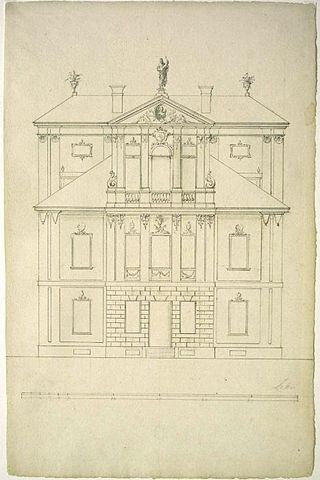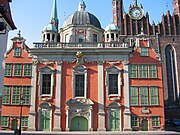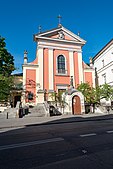Tylman van Gameren
Polish architect of Dutch origin (1632 – c. 1706) From Wikipedia, the free encyclopedia
Tylman van Gameren, also Tilman or Tielman and Tylman Gamerski,[1] (Utrecht, 3 July 1632 – c. 1706, Warsaw)[2] was a Dutch-born Polish[3][4] architect and engineer who, at the age of 28, settled in Poland and worked for Queen Marie Casimire, wife of Poland's King John III Sobieski. Tylman left behind a lifelong legacy of buildings that are regarded as gems of Polish Baroque architecture.[4]
Tylman van Gameren | |
|---|---|
 Self-portrait | |
| Born | Tylman van Gameren 3 July 1632 |
| Died | c. 1706 |
| Known for | Architecture |
| Movement | Baroque |
Life and professional career
Summarize
Perspective
Tylman was born in Utrecht, the Netherlands, and was trained by Jacob van Campen whilst the latter was busy building the Stadhuis on the Dam. Like many Dutch artists at the height of the Dutch Golden Age, Tylman left for Italy in 1650. While in Venice, he earned the reputation as a highly skilled painter of battle scenes.[4] In 1660, Tylman met in Leiden the Polish prince Jerzy Sebastian Lubomirski, the Grand Crown Marshall of the Polish–Lithuanian Commonwealth, and accepted his invitation to come to Poland as his architect and military engineer.[3]

Once in Warsaw, taking the name of Tylman Gamerski,[1] he soon became a rising star at court. For his first ten years there, he served as an artillery officer, designing fortifications. From 1670 on, he won fame as a court architect of palaces such as the Pałac Czartoryskich, gardens, country houses, monasteries and churches in and around Warsaw, designing (among others) churches of the Holy Ghost, St. Casimir, and St. Boniface. His designs are known as pearls of the Polish baroque and show Italian and Dutch influences.[5] One of the leading examples of his achievements is the Church of St. Anne (Polish: Kolegiata św. Anny) in the historic centre of Kraków, modelled on Sant'Andrea della Valle in Rome.[6] In 1676 the artist was appointed Golden Spur Knight, which allowed him to become a member of the Commonwealth society and marry Anna Komorowska.[4] In 1685 he was formally acknowledge by the Sejm as a Polish nobleman.[3]
Tylman acted as chief architect to Michał Korybut Wiśniowiecki, and John III Sobieski, and his works include the Gniński and Paca-Radziwiłł Palaces. He also completed the Krasiński Palace, begun in 1682 by Giuseppe Bellotti, whose sculptures were executed by Andreas Schlüter. Van Gameren left behind more than 70 grand buildings, a collection of 118 books and some 1,000 drawings.[3]
Most of his sketches, drafts and detailed plans have been preserved and show exceptional artistic quality, though 200 of them were lost in World War II. A unique on the European scale archive of Tylman van Gameren's work, at the University of Warsaw Library, include over 800 original design drawings of ecclesiastical buildings (including the Sisters of the Holy Sacrament Church and the Bernardine Church in Czerniaków district), epitaphs, tombstones, palaces (i.e. Krasiński Palace), villas, manor houses, public service buildings and fortifications.[7]
Tylman Gamerski died in Warsaw in 1706 and was buried in the Dominican Church on Cracow Foretown Street (unfortunately the church was pulled down in 1818 to build the Staszic Palace).[2]
Works
Aristocratic palaces
- Ostrogski Castle in Warsaw, after 1681
- Krasiński Palace in Warsaw, after 1677
- Bieliński Palace in Otwock Wielki, built 1682–1689
- Branicki Palace in Białystok, built 1691–1697
- Radziejowski Palace in Nieborów, built 1694
Churches and other projects
- St. Kazimierz Church in Warsaw, built 1688–1692
- St. Anne's Church in Kraków, rebuilt 1689–1703
- Lubomirski bathing pavilion, built 1683–1689
- Capuchin Church, Warsaw
See also
References
Literature
External links
Wikiwand - on
Seamless Wikipedia browsing. On steroids.










